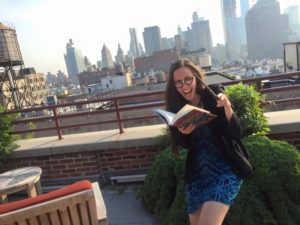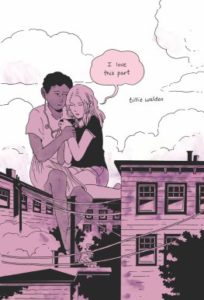The final Industry Insider interview for 2018 is with Kait Feldmann. And not to toot my own OPB horn here, but the following is SO GOOD that it’s totally worth sending out on Xmas eve. Feel free to tuck this post under your tree and wait to open it until Xmas day, if you want! 
That being said–here are 11 fun facts about Kait to get us started! Why 11 and not 10? Because at OPB, you always get a little extra literary love. Plus there’s always the This is Spinal Tap connection to be enjoyed.
- Her fancy title? “Editor at Arthur A. Levine Books, an imprint of Scholastic.”
- How many n’s in “Feldmann”? Two.
- When did she join Scholastic? May 2014.
- She assisted on Newbery Honor-winner Echo by Pam Muñoz Ryan, The Marvels by Brian Selznick, and The Tales of Beedle the Bard: The Illustrated Edition by J.K. Rowling, illustrated by Lisbeth Zwerger.
- “Book hoarder, insomniac, and lover of all things sloth.”
- She’s a “proud hapa.”
- Sometimes wishes “referral” were spelled “refferrall.” (Ryan’s note: Don’t we all?)
- What does Kait yearn for in a manuscript? “Meaningful, character-driven stories with humor and heart.”
- Also “likes a little whimsy, light layers of magic.” (Ryan’s note: Witness the Potterhead Q&A exchange below! And note what Kait’s both reading and holding in the picture above!)
- Wants to see more picture books featuring kids of color.
- Submission WARNING from Kait! “I have a stone-cold heart the size of a pea and am not moved by sweeping texts that explore ideas like love, family, tradition, etc., through a glimpse into many different kinds of experiences. Instead, I prefer to see specific narratives that focus on a particular character’s emotional journey. Universal through the specific!”
Arthur A. Levine website: www.arthuralevinebooks.com
Personal Website: www.kaitfeldmann.com
Twitter: www.twitter.com/kaitfeldmann
Tumblr: www.scattershotsilly.tumblr.com
Manuscript Wish List: www.manuscriptwishlist.com/mswl-post/kait-feldmann/
RVC: How did you first get involved with the publishing world?
KF: My first foray into publishing was an internship with Scholastic, which was offered after providing my mom (children’s book author Lisa Yee) notes on Warp Speed that she passed along to her editor, Arthur Levine. He liked what I had to say and asked me to intern for him. I hadn’t considered an editorial career before, but that experience ignited my passion, and I spent the rest of my college years taking on any kind of book-related work I could, interning remotely, assisting a local independent publisher, freelance editing, and selling fine writing pens in Vroman’s stationery department where I’d sneakily pretend to be a bookseller on the side.
RVC: So in your current editorial position at Arthur A. Levine Books, you’re primarily looking to acquire picture books and graphic novels. What appeals to you most about these ways of telling stories?
KF: Images bri ng something to a story that I think, when done right, can really enhance the world of words. And you can play with story in the book format in a way you simply can’t do in another medium. A great example is Tillie Walden’s I Love This Part, which I might call a middle-grade picture book. It follows two girls through their relationship and break up in glimpses—each spread a different scene from their love story, not necessarily in order. Tillie only uses two colors, but she plays with them thoughtfully, saturating scenes of affection with purple and going grayscale in times of turmoil. She also plays with proportion and surrealism in a way that you’re just going to have to see for yourself…some things words can’t properly express.
ng something to a story that I think, when done right, can really enhance the world of words. And you can play with story in the book format in a way you simply can’t do in another medium. A great example is Tillie Walden’s I Love This Part, which I might call a middle-grade picture book. It follows two girls through their relationship and break up in glimpses—each spread a different scene from their love story, not necessarily in order. Tillie only uses two colors, but she plays with them thoughtfully, saturating scenes of affection with purple and going grayscale in times of turmoil. She also plays with proportion and surrealism in a way that you’re just going to have to see for yourself…some things words can’t properly express.
RVC: Any advice on how to make this type of magic happen?
KF: Read widely. Really understand the ins and outs of the picture book form, know how to pace and paginate a story, study the way art is composed (notice the room left for text; the difference between spots, single pages, and full-bleed spreads…). This is important even if you’re a writer only! Make it a habit to browse your library or bookstore every month or so to get a feel for what’s out there. In a submission, I can tell who does this and who doesn’t.
RVC: Plenty of relatively competent submissions hit your desk daily, I’m sure. In fact, just tell us. What’s an average week for you? How many new submissions come at you?
KF: It fluctuates depending on a number of factors, including whether I’ve been to a conference recently and how responsive I’ve been to agents (I try to be speedy! The catch is that the quicker I respond, the more submissions I get—it creates a sort of Hydra effect that’s quite stressful!).
Taking a look at a random week, I see: six agented submissions (three are international—already published but looking for a North American/English-language publisher), and 72 unagented submissions.
RVC: How can you tell when writers haven’t done their homework for a submission? What’s the giveaway?
KF: Well, there’s the cosmetic stuff—I get a lot of “Dear Editorial Department,” “To Whom It May Concern,” or “Dear Kate Feldman” (note both first/last misspelled). It’s not an automatic rejection if you have a generic or misspelled salutation, but since it’s your VERY FIRST impression, it does stand out…in a bad way.
Then there’s the pitch. My acquisition profile is easily Googleable, as are most editors’ and agents’. My bailiwick is picture books and graphic novels but I get a lot of MG/YA novel submissions that are clearly copy-pasted from a template. I’m also very vocal and specific about publishing diverse books and creators, yet I get a number of queries that either ignore that or say “I know you’re interested in diversity so my book might not be for you but I’m going to try anyway.” What? No! That’s almost worse than not doing your homework. It’s taking the time to do your homework wrong and turning it in anyway.
Query letters are like cover letters—if you want to stand out you need to personalize each one you send to show why you are a great fit for that position. In a way…you are applying for a job. There’s a lot of work ahead, so show that you’re serious and have thought it through.
RVC: When a submission hits your desk and you’re intrigued, do you Google the author? If so, what are you looking for?
KF: Yup, I’m a Googler. I don’t always know what I’m looking for—I guess just a broader sense of who the person is. What they like. What they stand for. How active they are in the book community. And of course, any red flags! It hasn’t happened often, but there were a few instances where I came across a Tweet and thought ohhhh…yeah, we won’t get along.
RVC: So speaking of getting along … we first met at the SCBWI conference in Orlando this past June. What do you get out of being a speaker at events like that?
KF: I love discussing craft and publishing and find that I learn and grow from my experiences at writers conferences, too. And of course, I always hope to make lasting connections. One of the first authors I signed, the indomitable Aida Salazar, is someone I met at SCBWI LA. My colleague Nick Thomas had a critique with her and passed along her work. We both fell so hard for her writing that we offered a two-book deal right away. Her debut novel, The Moon Within (which Nick edited), comes out February 26, 2019 and her picture book, Jovita Wears Pants: The Story of a Revolutionary Fighter (that one’s mine!) follows in 2020.
RVC: Every editor and agent I speak with has a conference horror story or two–they were cornered in a bathroom stall, or someone slid 500 pages of a YA werefox thriller under their hotel door … three pages at a time … at 2 a.m. in the morning.
What’s YOUR conference-related writer horror story?
KF: Omg, can anyone beat the 2 a.m. page slide? Imagine the editor sitting on the other side, reading in suspense, waiting for the next pages to follow…(kidding—I’m sure that’s NOT what happened and don’t encourage that behavior).
Mine is the time I was talking to an author at a bar and a man asked to join us—he was friendly but very focused on me, wanted to know all about my interests outside of publishing. It didn’t read as flirtatious but it was clear he had an agenda, and that shifted the dynamic of the conversation in an uncomfortable way. A month or so later I’d forgotten all about it when I received a big box packed with my favorite things…and at the very bottom, a manuscript. From Bar Guy. It was completely inappropriate, and under Scholastic’s Code of Ethics, also considered a bribe.
RVC: That’s crazy. And speaking of crazy, here’s a semi-popular belief among writers: Editor’s don’t edit much anymore–they primarily just acquire (or more often, not!). While that might be true in some book areas, I don’t find that as valid to say about picture book editors.
How much time do you put in on any given picture book manuscript? How much before the sale is made? How much after?
KF: Is that true?? Perhaps in some circles, but that’s not how I was trained, and it’s not how I work! I typically schedule picture books to publish two years out from when I sign them, minimum! We go through rounds and rounds and rounds and rounds of editing. It really varies depending on the book and the creator and our working style—I try to adapt to provide what each creator needs from me, but sometimes neither of us knows what that looks like until we’ve taken a few different tacks!
There’s one creator who I approached cold and asked to develop a project from scratch—we worked for ten months on creating a story I could share with my acquisition team—but all that time working together and figuring out our style meant that by the time we officially signed it up we were flying.
RVC: What’s the most common misconception about being a picture book editor? What do authors–and possibly even agents–have wrong?
KF: The best way to make a children’s book editor bristle is to say “Oh how cute! You edit picture books? That must be so easy!” But I’m sure your readers know well…IT ISN’T EASY!
The one thing that bothers me even more, however, is people who underestimate the picture book audience. First of all, we should be writing UP to kids, not down. Kids are so smart, emotionally and intellectually, and they know instantly when their worth is being devalued. Second, picture books are not just for kids. They’re for anyone who loves a good story!
RVC: Alright–it’s time for the Speed Round! Go! What zoo animal deserves more picture book coverage?
KF: I’m very happy that sloths are finally having their moment, but they deserve moooooore!!!
RVC: You semi-frequently tweet about amazing workplace discoveries. The office copier’s ability to corner staple. The “move to folder” dropdown in Outlook. What’s the latest breakthrough?
KF: The secret tunnel that leads to a cupcake store. You think I’m kidding.
RVC: Grammar gaff that drives you the most bonkers?
KF: Er…I’m not the bestest at grammar myself.
grammar myself.
RVC: You’ve openly confessed to being a Potterhead. Spill the (Bertie Bott’s Every Flavour) beans. Most underappreciated character?
RVC: Three current picture book authors who are setting/raising the bar?
KF: Jessica Love (Julián Is a Mermaid); Minh Lê (Drawn Together, illustrated by Dan Santat); Tillie Walden (I Love This Part).
RVC: The most unforgivable thing in a picture book submission is …
KF: Getting the person’s name wrong!
RVC: What would like to see written on your literary tombstone?
KF: Here lies Kait, who died as she lived, under a pile of books.
RVC: Thanks so much, Kait. What a way to wrap up the first year of OPB! Thanks!!

